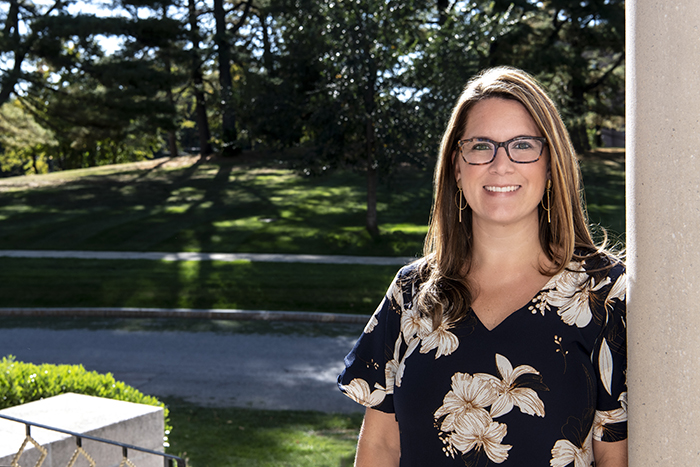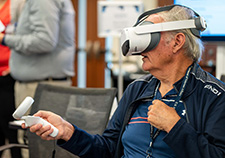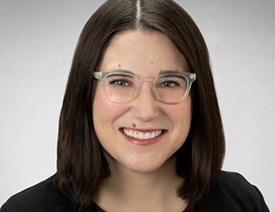Office of Research & Development |
 |
Office of Research & Development |
 |


Katie Fitzgerald Jones of the VA Boston Healthcare System served as first author of a study that signals there is a research gap in how to optimize treatment for cancer-related pain and opioid use disorder. (Photo courtesy of Katie Fitzgerald Jones)
July 26, 2022
By Mike Richman
VA Research Communications
"Opioids are almost never a first-time treatment for pain. But in people with moderate to severe cancer-related pain, they are the foundation of treatment."
VA has a series of important programs to optimize the safety of opioids, a class of pain-relieving drugs that carry the risk of misuse, addiction, and overdose because they can induce euphoric feelings.
Those programs include the Opioid Safety Initiative (OSI), which focuses on the safe management of opioid therapy for chronic pain. OSI has been linked to a relative decline in high-risk opioid prescribing in VA but has generally been focused on non-cancer chronic pain.

VA opens new research center to seek novel arthritis treatments

Injectable gel could help treat degenerative back pain

Virtual reality technology helps Veterans in pain

Photos shed light on food insecurity in post 9/11 Veterans
What about cancer-related chronic pain? There’s a lack of consensus in the scientific community on how to treat cancer patients who struggle with opioid use disorder or prescription opioid misuse. Opioid use disorder is a problematic pattern of opioid use leading to serious impairment or distress. Opioid misuse means a patient is not taking the drug in ways it was prescribed, such as taking too much of a prescribed drug or using it with a non-prescribed substance like alcohol or benzodiazepines. Opioid misuse is not necessarily a substance use disorder, but it can signal a problem or result in opioid-related harms.
“Opioids are almost never a first-time treatment for pain,” says Katie Fitzgerald Jones, a palliative and addiction nurse practitioner at the VA Boston Healthcare System. “But in people with moderate to severe cancer-related pain, they are the foundation of treatment. There’s almost no way to avoid them. Providing opioids for people with a history of opioid use disorder and opioid misuse is especially complicated for Veterans with cancer since Veterans are at higher risk of unintentional opioid overdose. Part of the challenge with the Veteran population is that there are a lot of comorbidities like PTSD, anxiety, and depression, and medical comorbidities like alcohol use disorder and COPD that increase the risk for overdose or other opioid-related harms.”
Jones cares for many cancer patients with a co-occurring substance use disorder who also require opioids to manage pain. About 7% of Veterans with cancer also have a substance use disorder.
“How to best care for people with substance use disorders, such as opioid use disorder, is especially complex in people with cancer because prognoses can widely vary and influence opioid decisions,” says Jones, who is completing her doctorate at Boston College. “It’s important when prescribing opioids that you attend to safety while also addressing pain. People with untreated opioid use disorder or concerning opioid behaviors, such as taking more opioids than prescribed or using opioids with unprescribed medications like benzodiazepines, are at increased risk for opioid-related harm.”
With that in mind, Jones embarked on learning how to best manage advanced cancer pain in patients with co-occurring opioid use disorder or opioid misuse. She’s the first author of a study that outlines guidance for treating cancer patients who have struggled with opioid use disorder or opioid misuse. The study also highlights research and policy gaps that warrant urgent attention to meet the needs of people with cancer pain and a history of problematic opioid use.

Dr. Jessica Merlin of the University of Pittsburgh led the research.
Dr. Jessica Merlin, an associate professor of general internal medicine at the University of Pittsburgh, led the research.
The findings appeared in JAMA Oncology in June 2022.
The researchers surveyed nurse practitioners and doctors with expertise in palliative care and addiction to better understand how they treat cancer patients with opioid misuse or opioid use disorder. The investigators used on online methodology to explore consensus among 120 palliative care and addiction experts about management strategies for a hypothetical 50-year-old male with advanced cancer pain and either a history of opioid use disorder or prescription opioid misuse.
The research team asked the participants to rate and comment on management strategies, such as prescribing methadone and buprenorphine. Consensus was investigated for three clinical scenarios: a patient with a history of an untreated opioid use disorder, a patient taking more opioids than prescribed, and a patient using non-prescribed benzodiazepines, which can cause an overdose when combined with opioids.
The participants discussed scenarios relevant to opioid use disorder and opioid misuse. They gave their first response, listened to what other people had to say, then committed to an answer. “You didn’t have to change your initial answer, but the idea is that you reflected and perhaps revised it based on group discussion and feedback,” Jones explains.
For the purposes of the study, palliative care didn’t necessarily refer to patients at end of life.
“Palliative care clinicians often see patients with advanced cancer who have pain that's not controlled,” Merlin says. “We were asking people to comment on folks who were not at the end of life, and that’s very typical of somebody in palliative care.”
Jones’ study focused on two FDA-approved drugs for treating cancer pain and opioid use disorder: buprenorphine and methadone. Buprenorphine is a safer opioid because it doesn’t promote overdose like methadone does.
Plus, buprenorphine and methadone are regulated differently when used for pain control versus opioid use disorder. When prescribing those drugs for pain, clinicians are required to hold only a Drug Enforcement Administration (DEA) license. But extra barriers exist when the same drugs are prescribed for opioid use disorder, which can be difficult to diagnose and can co-occur with pain. Methadone is legal for treating opioid use disorder only in licensed methadone treatment programs. VA operated 32 of those programs as of 2018.
To prescribe buprenorphine for opioid use disorder, clinicians must have what’s known as a DEA X-waiver. Currently, only about 5% of clinicians in the country hold a DEA X-waiver to prescribe buprenorphine for opioid use disorder.
Jones and her team found that the use of buprenorphine for opioid use disorder and cancer pain was appropriate, but its use for opioid misuse and cancer pain was less clear. The palliative care and addiction clinicians also considered methadone an important tool for treating opioid use disorder and cancer pain, but policy and safety concerns exist, including the fact that methadone can only be distributed in a licensed clinic.
“Our study highlights that there is a knowledge and research gap in how to optimize the treatment for cancer-related pain and opioid use disorder,” Jones says. “Clinicians need more training on using buprenorphine and more evidence to implement that drug for opioid misuse behaviors.
“Cancer and opioid-misuse-opioid use disorder are important comorbid conditions,” she adds. “Clinicians must be equipped to provide compassionate and safe evidence-based care. This study provides important information that existing policies isolating addiction care from the rest of health care are problematic for all including people with cancer. As a result, clinicians are circumventing the system and perhaps putting themselves and their patients at risk for harm. Policy innovation is sorely needed.”
VA Research Currents archives || Sign up for VA Research updates